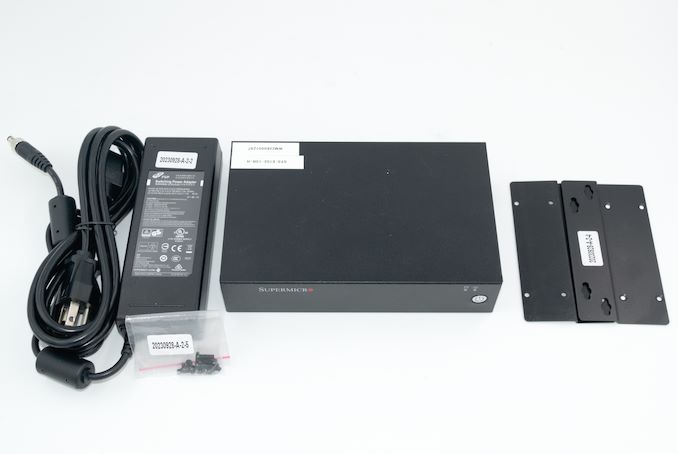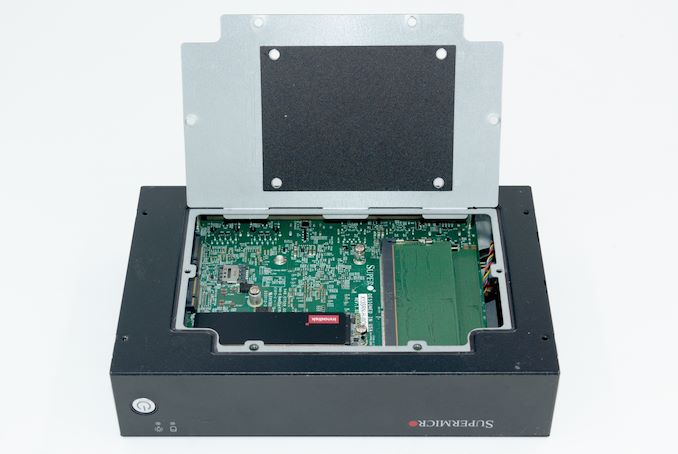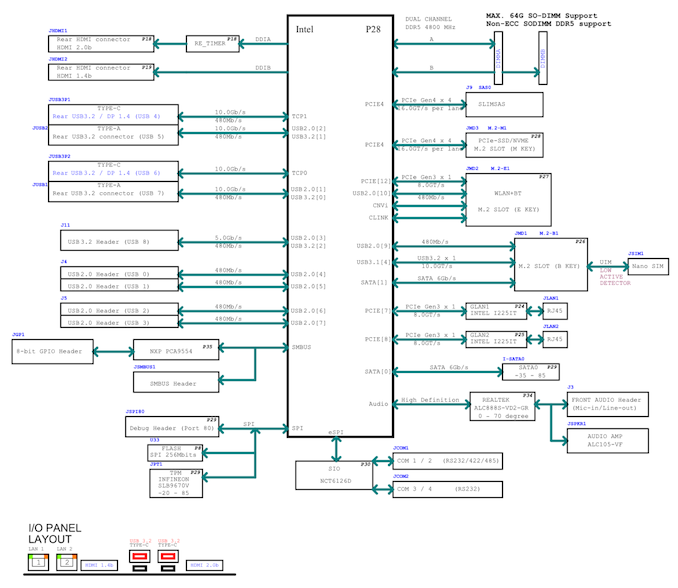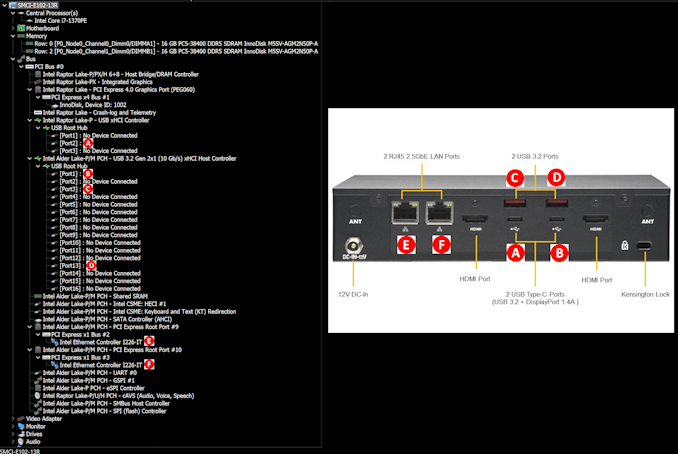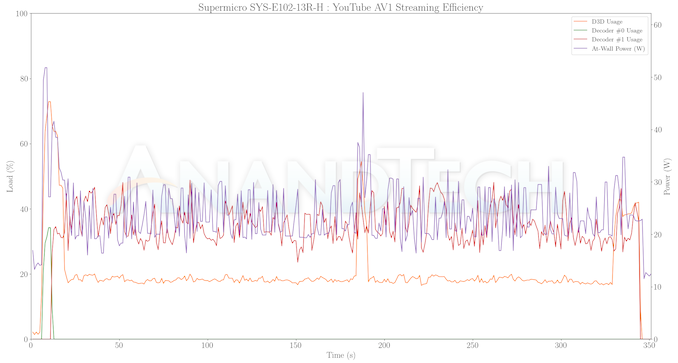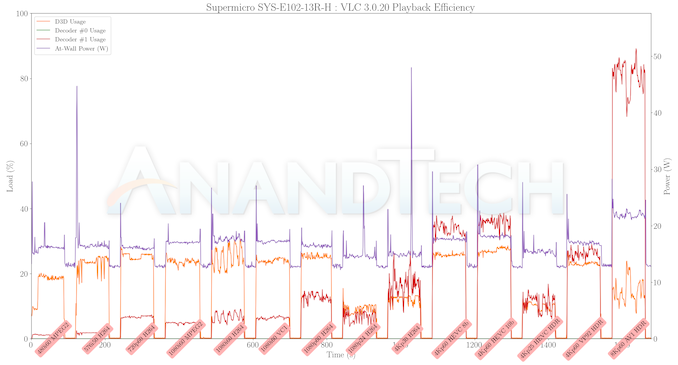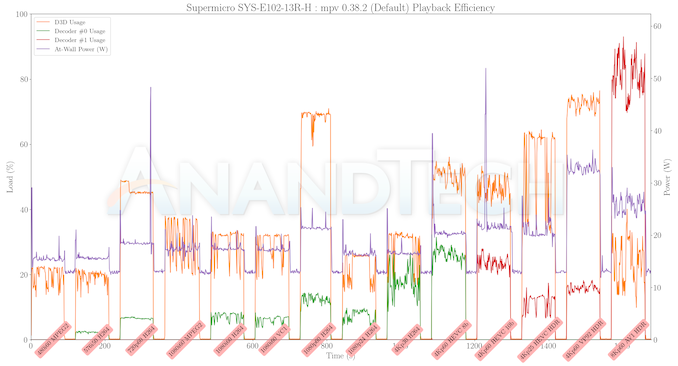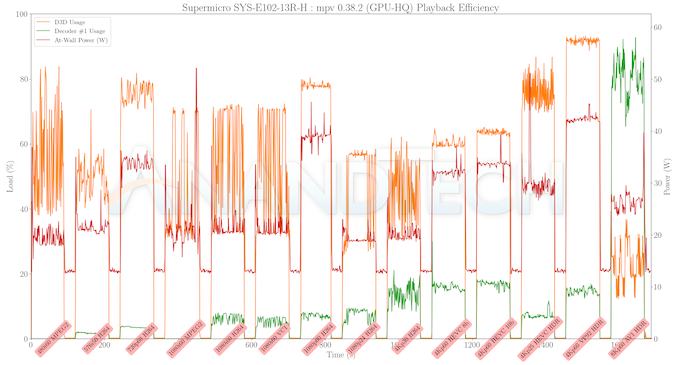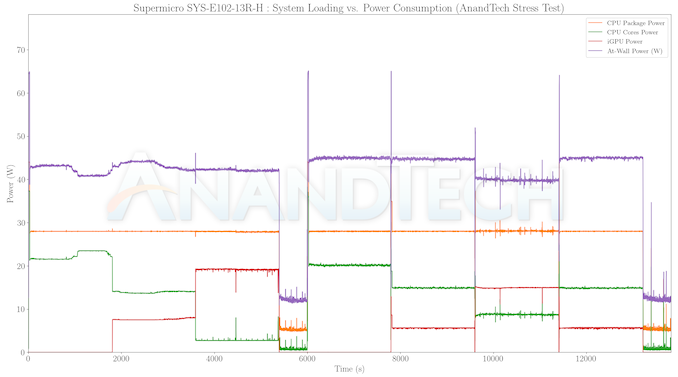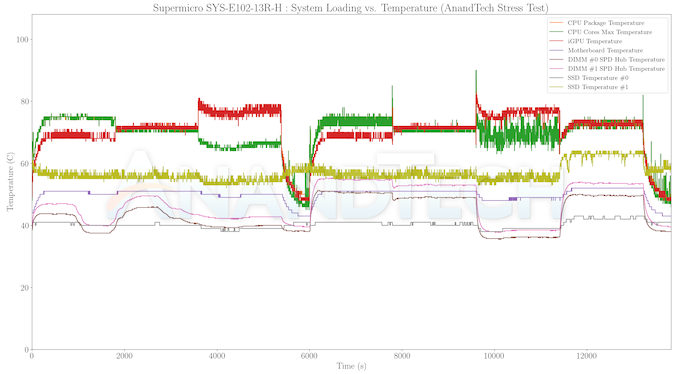
Original Link: https://www.anandtech.com/show/21384/supermicro-e10213re-review-a-raptor-lakep-35-sbc-system-for-embedded-applications
Supermicro E102-13R-H Review: A Raptor Lake-P 3.5-inch SBC System for Embedded Applications
by Ganesh T S on May 14, 2024 8:00 AM EST- Posted in
- Systems
- Intel
- Embedded
- Supermicro
- Mini-PC
- Raptor Lake-P

Single-board computers in the 3.5-inch form-factor have become extremely popular for embedded applications involving a mix of high performance requirements as well as extended peripherals support. Typical use-case scenarios include digital signage, edge inferencing solutions, retail applications, and IoT gateways. The requirements in these deployments call for processors and components that can operate in a wide temperature range. The chassis and cooling solution handle other duties such as ruggedness and avoidance of moving parts.
The Supermicro X13SRN-H-WOHS is a 3.5-inch SBC with a soldered-down Intel Core i7-1370PE - a Raptor Lake-P embedded processor with vPro support. It has plenty of I/O support, including a SlimSAS PCIe expansion slot. Supermicro also offers a ready-to-deploy solution using the SBC in the actively-cooled SYS-E102-13R-H box PC. A majority of the motherboard ports are left un-used in this configuration, but the exposed ones should suffice for the most common use-cases.
The review below takes a detailed look at the features and performance profile of the SYS-E102-13R-H, along with an evaluation of the thermal solution.
Introduction and Product Impressions
Supermicro's SYS-E102-13R-H box PC is based on the company's X13SRN-H-WOHS 3.5-inch SBC board. WOHS stands for 'Without-Integrated-Heat-Sink'. The board is also available in a version with an integrated heat sink for users needing access to all of the motherboard's I/O features. The SYS-E102-13R-H box PC takes the WOHS board variant and places it in the CSE-E102TF2 - a compact enclosure with a single 40 x 40 x 15 mm fan on one side. The chassis provides support for external WLAN antennae, along with cut-outs for all the external I/O ports on the board. The front of the case has the power button alone, with all the other features relegated to the rear.
Despite the SYS-E102-13R-H being tagged as an IoT SuperServer, the system does not support ECC memory or in-band ECC. There is no separate BMC, but that is not a surprise for a machine based on a 3.5-inch SBC board. However, to make up for that, the SYS-E102-13R-H does support vPro and remote management capabilities use AMT. The system also supports Supermicro's monitoring utility 'SuperDoctor' - this allows Nagios integration for centralized infrastructure monitoring.
The box PC forsakes many of the interesting I/O capabilities of the internal board (such as the multitude of USB and SATA ports, as well as the PCIe SlimSAS port that can be used for additional expansion). The user gets two USB 3.2 Gen 2 Type-A ports and two USB 3.2 Gen 2 Type-C ports (10 Gbps each). Two NBASE-T RJ-45 connectors (up to 2.5 Gbps) are available.
In addition to the main unit, Supermicro supplies a lockable 12V 7A (84W) DC power adapter and mounting hardware for the system.
Access to the SSD and RAM slots are via a removable panel on the underside kept in place with the aid of four screws.
The underside has three M.2 slots - two for M.2 2280 SSDs, and one for a M.2 2230 WLAN / BT card. A nano-SIM slot is also easily accessible near between the first two M.2 slots.
Our review system came pre-installed with 2x 16GB DDR5 SO-DIMMs and a PCIe 3.0 x4 NVMe drive (despite the system supporting PCIe 4.0 x4 drives in the M.2 slots). The full specifications of the review sample are provided in the table below.
| Supermicro SYS-E102-13R-H Specifications (as tested) |
|
| Processor | Intel Core i7-1370PE Raptor Lake 6P + 8E / 20T, 1.9 - 3.7 GHz (E) / 4.8 GHz (P) Intel 7, 24 MB L2, 28 W (PL1 = 28 W / PL2 = 44 W) |
| Memory | InnoDisk M5SV-AGM2N50P-A DDR5-4800 SODIMM 40-39-39-77 @ 4800 MT/s 2x16 GB
|
| Graphics | Intel Iris Xe Graphics (96EU @ 1.4 GHz) |
| Disk Drive(s) | Innodisk M.2 (P80) 3TE6 DEM28-B56DD1GWAQF (256 GB; M.2 2280 PCIe 3.0 x4;) (96L 3D TLC; Maxio MAP1002 NVMe 1.3 Controller) |
| Networking | 2x 2.5GbE RJ-45 (Intel I226-IT) |
| Audio | Realtek ALC888 Audio Codec On-board (Optional Audio Jack, N/A in Review System) Audio Bitstreaming Support over HDMI Ports |
| Video | 1x HDMI 2.0b 1x HDMI 1.4b 2x DisplayPort 1.4 (via Type-C ports) |
| Miscellaneous I/O Ports | 2x USB 3.2 Gen 2 Type-A (Rear) 2x USB 3.2 Gen 2 Type-C (Rear) |
| Operating System | Windows 11 Enterprise (22631.3257) |
| Pricing | (Street Pricing on May 9th, 2024) US $1002 (Barebones) US $1210 (as configured, no OS) |
| Full Specifications | Supermicro SuperServer SYS-E102-13R-H Specifications |
The SSD and RAM supplied along with the review sample are both rated for wide-temperature operation. These are necessary for specific deployment scenarios.
In the next section, we take a look at the system setup and follow it up with a detailed platform analysis.
Setup Notes and Platform Analysis
Our review sample of the Supermicro SYS-E102-13R-H came with all necessary components pre-installed - we only had to load up the OS to start our evaluation process. Prior to that, we took some time to look into the BIOS interface. It must be noted that the processor used in the system is vPro-enabled, and the Intel Management Engine BIOS Extensions can be used to set up AMT for remote management. As is typical for systems targeting the embedded market, the main BIOS interface is a vanilla one. It does provide plenty of configuration options. The video below presents the entire gamut of available options.
The block diagram for the internal board below presents the overall high-speed I/O distribution.
The key takeaway from the block diagram is the extensive support for embedded applications, while also sporting an aggressive outlook in terms of bandwidth allocation. Two separate x1 lanes are allocated to each Intel I226-IT controller for the dual 2.5 GbE LAN ports. There are plenty of serial and digital I/O ports connected to the SMBUS and eSPI pins o the SoC. Hardware TPM is available on board, and a SIM slot is also integrated - particularly useful for cases where the system gets deployed with 4G / 5G connectivity. The USB ports in the rear are all Gen 2 (10Gbps), and there are plenty of USB 2.0 headers for hooking up legacy equipment. Unfortunately, things are limited by the case used in the SYS-E102-13R-H.
One of the Type-C ports is serviced directly from the Type-C output of the main processor (usually used for Thunderbolt support in systems targeting the consumer market). All the other ports are from the PCH in the package.
In today's review, we compare the Supermicro SYS-E102-13R-H and a host of other systems based on processors with TDPs ranging from 15W to 35W. The systems do not target the same market segments, but a few key aspects lie in common, making the comparisons relevant.
| Comparative PC Configurations | ||
| Aspect | Supermicro SYS-E102-13R-H | |
| CPU | Intel Core i7-1370PE Raptor Lake 6P + 8E / 20T, 1.9 - 3.7 GHz (E) / 4.8 GHz (P) Intel 7, 24 MB L2, 28 W (PL1 = 28 W / PL2 = 44 W) |
Intel Core i7-1370PE Raptor Lake 6P + 8E / 20T, 1.9 - 3.7 GHz (E) / 4.8 GHz (P) Intel 7, 24 MB L2, 28 W (PL1 = 28 W / PL2 = 44 W) |
| GPU | Intel Iris Xe Graphics (96EU @ 1.4 GHz) |
Intel Iris Xe Graphics (96EU @ 1.4 GHz) |
| RAM | InnoDisk M5SV-AGM2N50P-A DDR5-4800 SODIMM 40-39-39-77 @ 4800 MT/s 2x16 GB |
InnoDisk M5SV-AGM2N50P-A DDR5-4800 SODIMM 40-39-39-77 @ 4800 MT/s 2x16 GB |
| Storage | Innodisk M.2 (P80) 3TE6 DEM28-B56DD1GWAQF (256 GB; M.2 2280 PCIe 3.0 x4;) (96L 3D TLC; Maxio MAP1002 NVMe 1.3 Controller) |
Innodisk M.2 (P80) 3TE6 DEM28-B56DD1GWAQF (256 GB; M.2 2280 PCIe 3.0 x4;) (96L 3D TLC; Maxio MAP1002 NVMe 1.3 Controller) |
| Wi-Fi | 2x 2.5GbE RJ-45 (Intel I226-IT) | 2x 2.5GbE RJ-45 (Intel I226-IT) |
| Price (in USD, when built) | (Street Pricing on May 9th, 2024) US $1002 (Barebones) US $1210 (as configured, no OS) |
(Street Pricing on May 9th, 2024) US $1002 (Barebones) US $1210 (as configured, no OS) |
The next few sections will deal with comparative benchmarks for the above systems.
System Performance: UL and BAPCo Benchmarks
Our 2022 Q4 update to the test suite for Windows 11-based systems carries over some of the standard benchmarks we have been using over the last several years, including UL's PCMark. New additions include BAPCo's CrossMark multi-platform benchmarking tool, as well as UL's Procyon benchmark suite.
UL PCMark 10
UL's PCMark 10 evaluates computing systems for various usage scenarios (generic / essential tasks such as web browsing and starting up applications, productivity tasks such as editing spreadsheets and documents, gaming, and digital content creation). We benchmarked select systems with the PCMark 10 Extended profile and recorded the scores for various scenarios. These scores are heavily influenced by the CPU and GPU in the system, though the RAM and storage device also play a part. The power plan was set to Balanced for all the PCs while processing the PCMark 10 benchmark. The scores for each contributing component / use-case environment are also graphed below.
| UL PCMark 10 - Performance Scores | |||
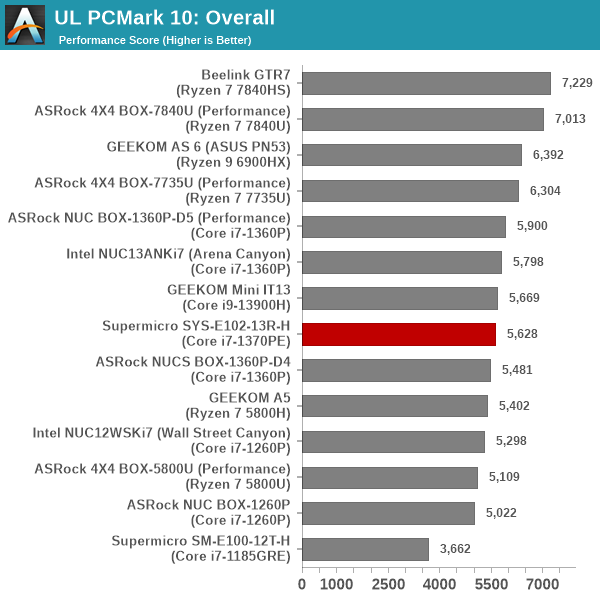
The SYS-E102-13R-H is held back by two aspects - the 28W PL1 setting and the use of DDR5-4800 RAM. As a result, the system makes its appearance in the middle of the pack in the above graphs, with higher TDP systems managing to easily surpass it in the performance numbers.
UL Procyon v2.1.544
PCMark 10 utilizes open-source software such as Libre Office and GIMP to evaluate system performance. However, many of their professional benchmark customers have been requesting evaluation with commonly-used commercial software such as Microsoft Office and Adobe applications. In order to serve their needs, UL introduced the Procyon benchmark in late 2020. There are five benchmark categories currently - Office Productivity, AI Inference, Battery Life, Photo Editing, and Video Editing. AI Inference benchmarks are available only for Android devices, while the battery life benchmark is applicable to Windows devices such as notebooks and tablets. We presents results from our processing of the other three benchmarks.
| UL Procyon - Office Productivity Scores | |||
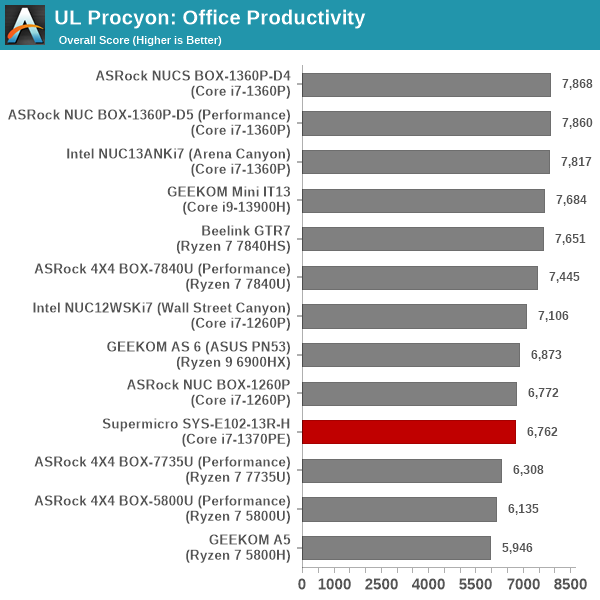
The trend in the scores is similar to what was observed in the PCMark 10 workloads, largely for the same reasons - low PL1 and entry-level speeds for the DDR5 RAM.
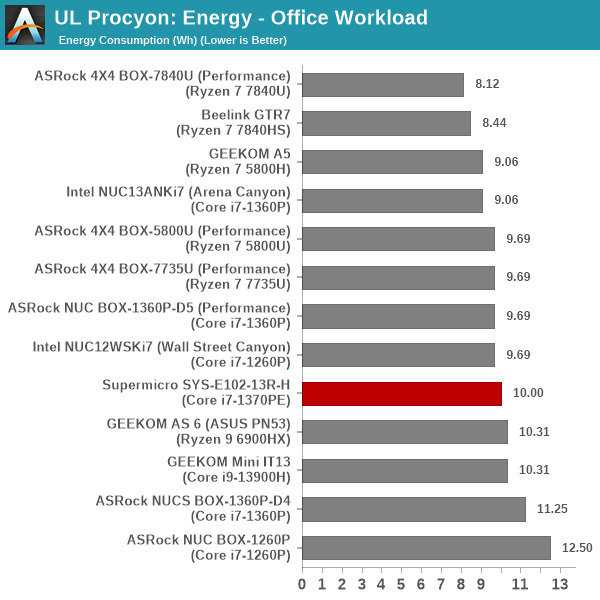
From an energy consumption viewpoint, the system fares slightly better due to the lower PL1 setting, and lower DRAM power. These aspects help the SYS-E102-13R-H provide better energy efficiency compared to most of the other systems.
Moving on to the evaluation of Adobe Photoshop and Adobe Lightroom, we find the SYS-E102-13R-H in the middle of the pack, thanks to the available power budget and RAM speeds.
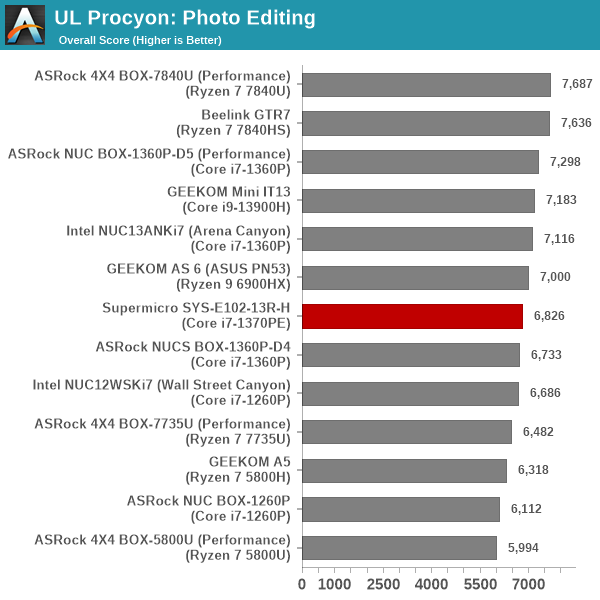
The same aspects help the system on the energy efficiency front, similar to what was observed in the Office workloads.
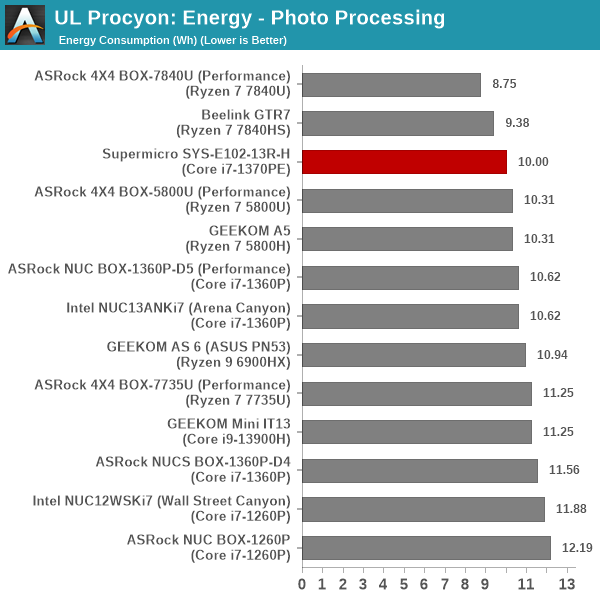
UL Procyon evaluates performance for video editing using Adobe Premier Pro.
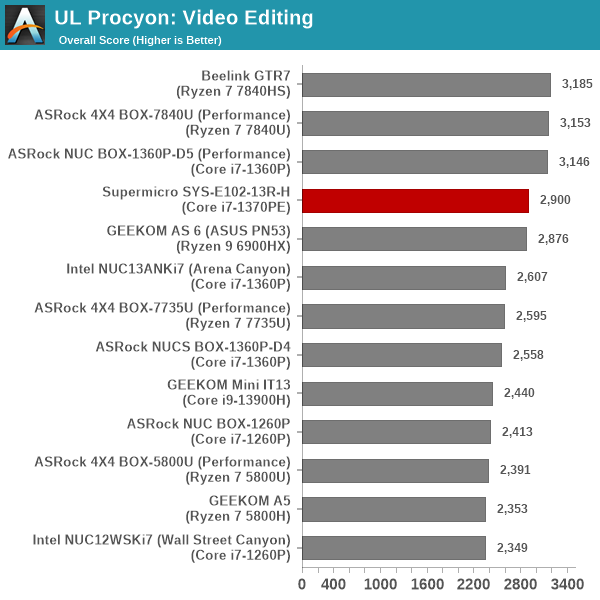
The relative positioning of the SYS-E102-13R-H is similar to what was seen in the Office and Photo Processing workloads, largely for the same reasons.
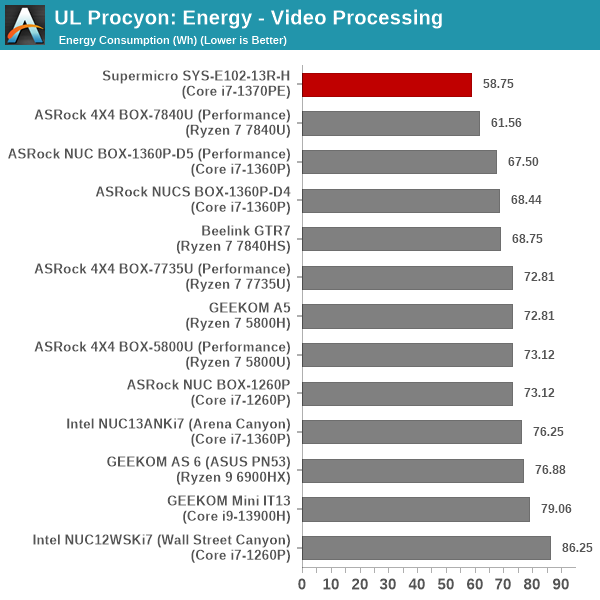
On the energy efficiency front, the system comes out on top by a healthy margin, indicating that the configuration of the system is optimal for energy-efficiency video encoding.
BAPCo CrossMark 1.0.1.86
BAPCo's CrossMark aims to simplify benchmark processing while still delivering scores that roughly tally with SYSmark. The main advantage is the cross-platform nature of the tool - allowing it to be run on smartphones and tablets as well.
| BAPCo CrossMark 1.0.1.86 - Sub-Category Scores | |||
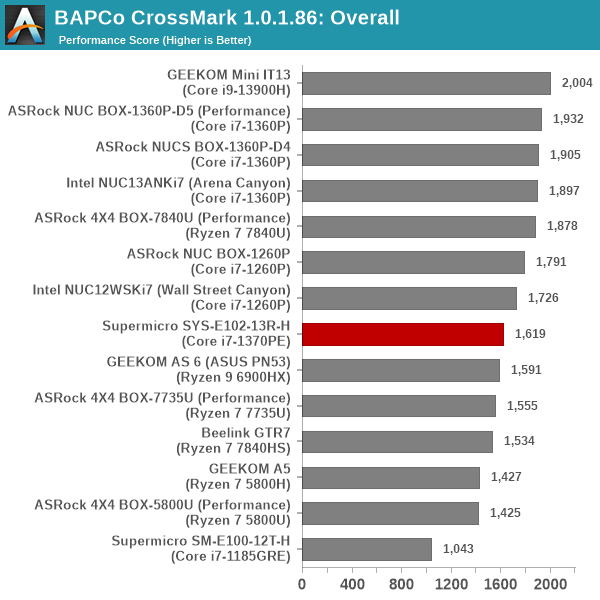
The relative performance numbers seen in the UL benchmarks also translate to CrossMark, as expected. The responsiveness ratings vary significantly due to the usage of a Gen 3 SSD in the SYS-E102-13R-H, compared to Gen 4 ones in others. Other numbers directly correlate with the PL1 values of the processor in the systems.
System Performance: Application-Specific Workloads
Standardized benchmarks such as UL's PCMark 10 and BAPCo's CrossMark take a holistic view of the system and process a wide range of workloads to arrive at a single score. Some systems are required to excel at specific tasks - so it is often helpful to see how a computer performs in specific scenarios such as rendering, transcoding, JavaScript execution (web browsing), etc. This section presents focused benchmark numbers for specific application scenarios.
3D Rendering - CINEBENCH R23
We use CINEBENCH R23 for 3D rendering evaluation. R23 provides two benchmark modes - single threaded and multi-threaded. Evaluation of different system configurations in both supported modes provided us the following results.
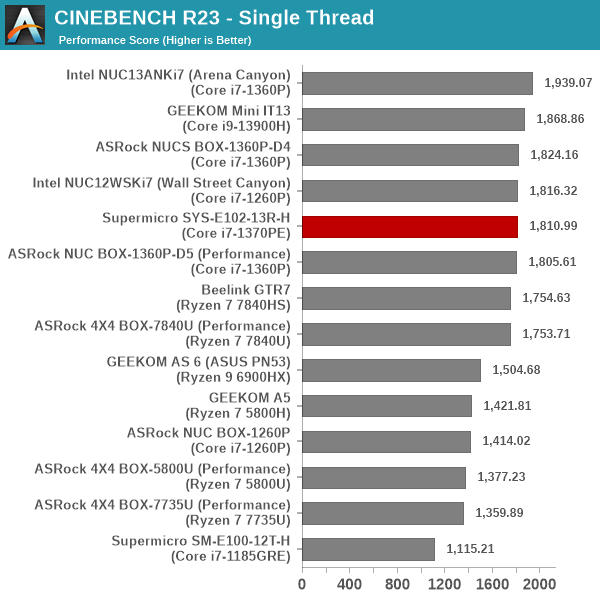
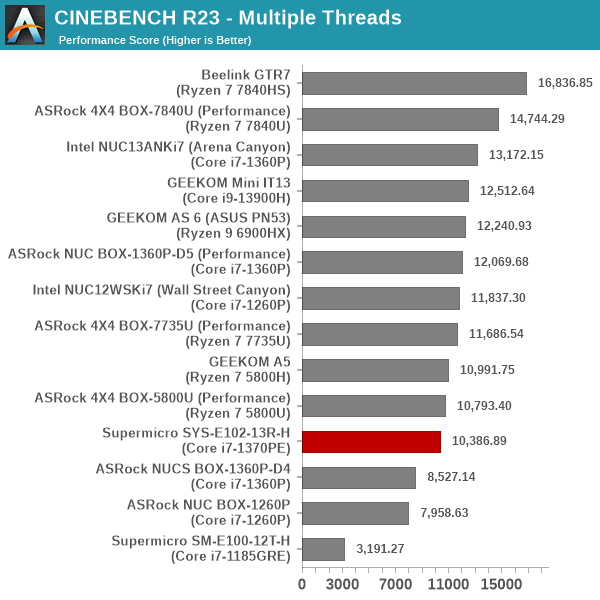
The scores in the single-threaded case reflect the sustained PL1 power budget of the processors in different systems. The multi-threaded case sees systems equipped with larger number of high-performance cores and higher power budget scoring well.
Transcoding: Handbrake 1.5.1
Handbrake is one of the most user-friendly open source transcoding front-ends in the market. It allows users to opt for either software-based higher quality processing or hardware-based fast processing in their transcoding jobs. Our new test suite uses the 'Tears of Steel' 4K AVC video as input and transcodes it with a quality setting of 19 to create a 720p AVC stream and a 1080p HEVC stream.

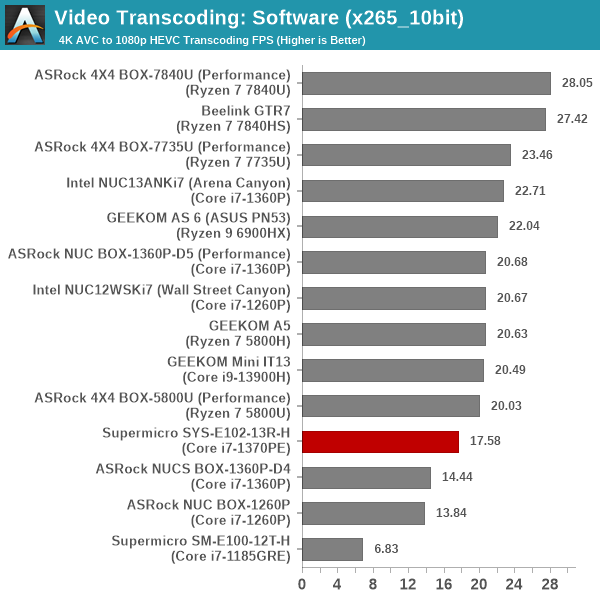
Systems with larger number of high-performance cores and higher power budget tend to perform better in software transcoding scenarios, and we see that getting played out in the FPS numbers in the above two graphs.
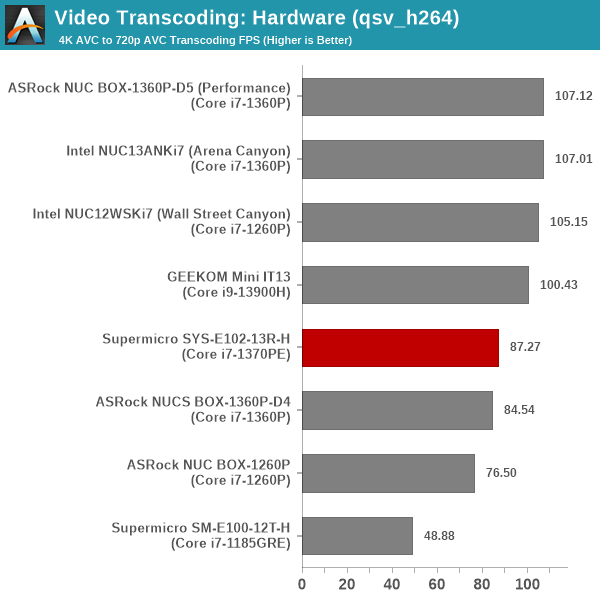
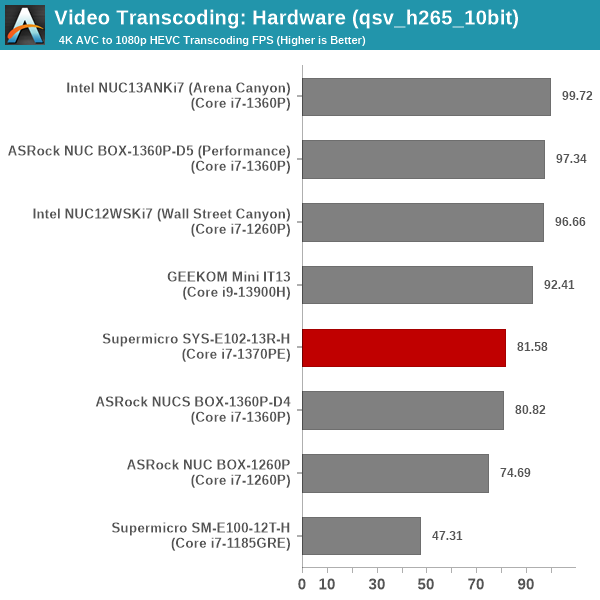
QuickSync transcoding rates are a function of the GPU clock rate. The higher the power budget, the faster the GPU can clock (in most cases). This is reflected in the relative ordering of different systems in the above two graphs.
Archiving: 7-Zip 21.7
The 7-Zip benchmark is carried over from our previous test suite with an update to the latest version of the open source compression / decompression software.
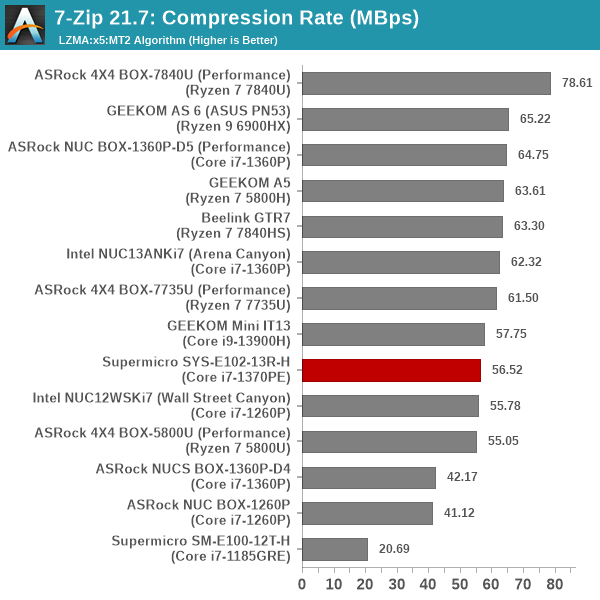

The program is able to make good use of multiple cores and the available power budget. Again, we see higher PL1 processors and those with larger number of high-performance cores faring better in the benchmarks.
Web Browsing: JetStream, Speedometer, and Principled Technologies WebXPRT4
Web browser-based workloads have emerged as a major component of the typical home and business PC usage scenarios. For headless systems, many applications based on JavaScript are becoming relevant too. In order to evaluate systems for their JavaScript execution efficiency, we are carrying over the browser-focused benchmarks from the WebKit developers used in our notebook reviews. Hosted at BrowserBench, JetStream 2.0 benchmarks JavaScript and WebAssembly performance, while Speedometer measures web application responsiveness.
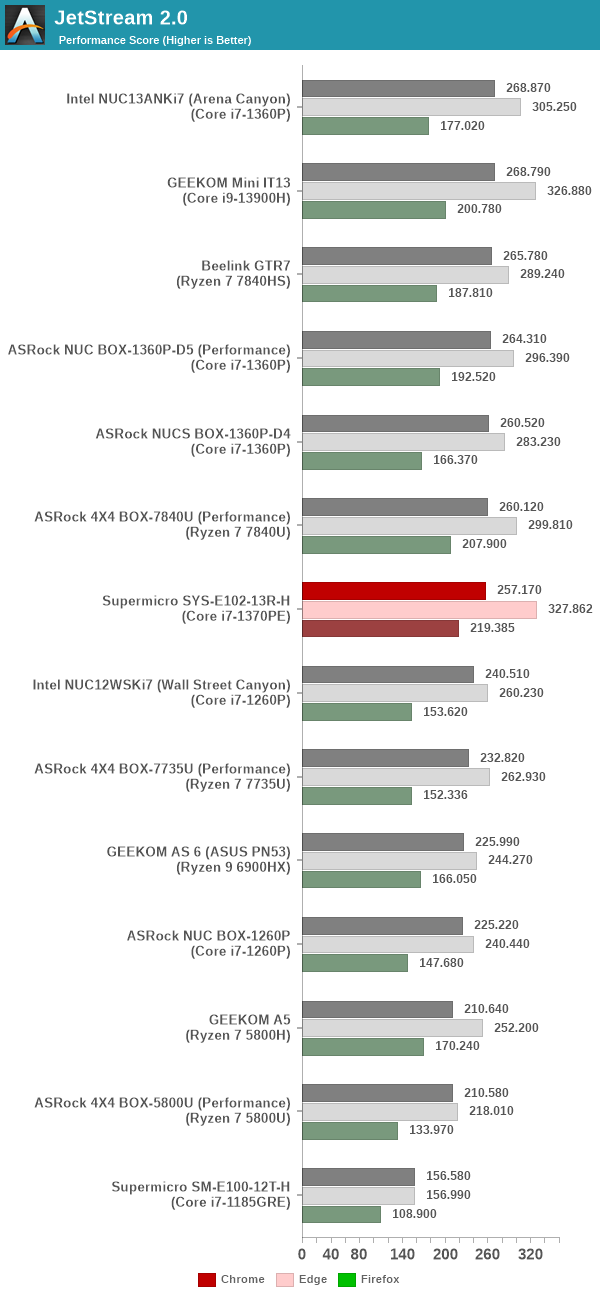

From a real-life workload perspective, we also process WebXPRT4 from Principled Technologies. WebXPRT4 benchmarks the performance of some popular JavaScript libraries that are widely used in websites.
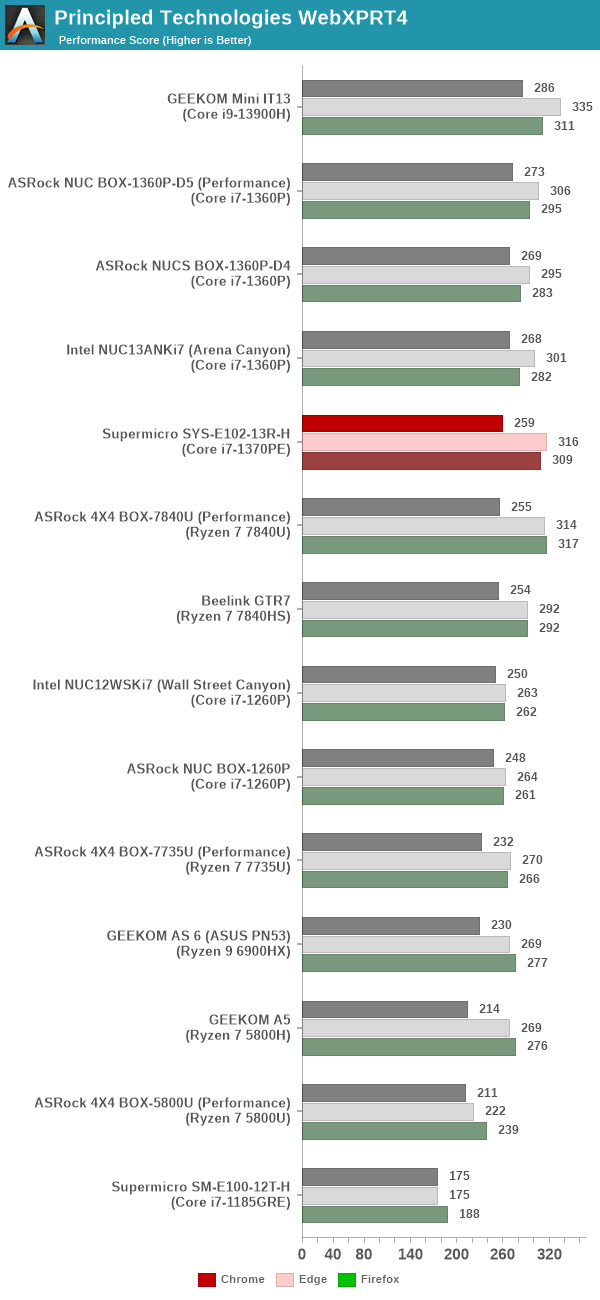
For a given power budget, the Intel-based systems in each generation easily outperforms the corresponding AMD-based systems. The SYS-E102-13R-H makes its mark in the upper half of the pack in different browser benchmarks, with the sustained power budget of 28W proving to be the limiting factor.
Application Startup: GIMP 2.10.30
A new addition to our systems test suite is AppTimer - a benchmark that loads up a program and determines how long it takes for it to accept user inputs. We use GIMP 2.10.30 with a 50MB multi-layered xcf file as input. What we test here is the first run as well as the cached run - normally on the first time a user loads the GIMP package from a fresh install, the system has to configure a few dozen files that remain optimized on subsequent opening. For our test we delete those configured optimized files in order to force a 'fresh load' every second time the software is run.
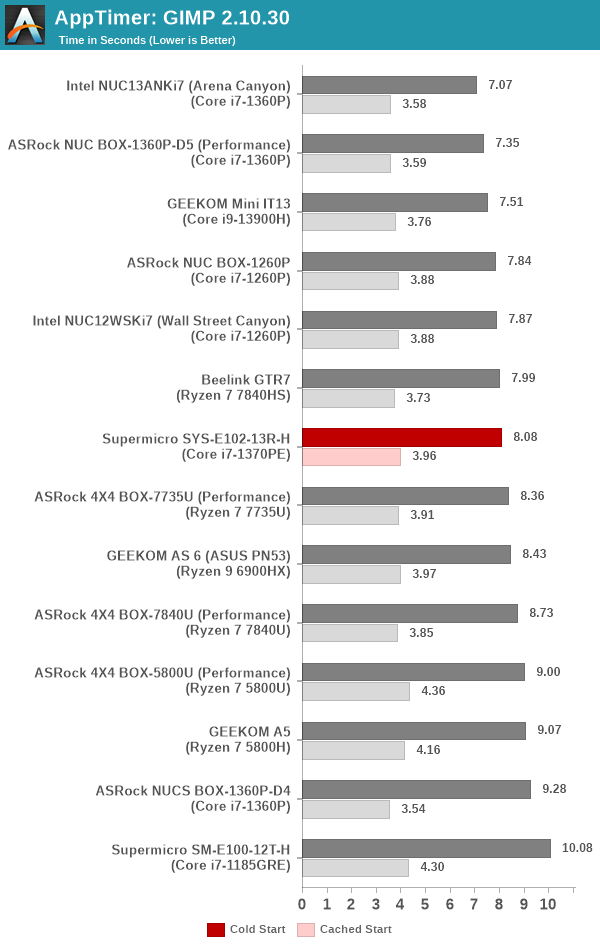
As it turns out, GIMP does optimizations for every CPU thread in the system, which requires that higher thread-count processors take a lot longer to run. So the test runs quick on systems with fewer threads, however fast cores are also needed. Eventually, the PL1 limits end up placing the SYS-E102-13R-H in the middle of the pack for application loading times.
Cryptography Benchmarks
Cryptography has become an indispensable part of our interaction with computing systems. Almost all modern systems have some sort of hardware-acceleration for making cryptographic operations faster and more power efficient. In the case of IoT servers, many applications - including web server functionality and VPN - need cryptography acceleration.
BitLocker is a Windows features that encrypts entire disk volumes. While drives that offer encryption capabilities are dealt with using that feature, most legacy systems and external drives have to use the host system implementation. Windows has no direct benchmark for BitLocker. However, we cooked up a BitLocker operation sequence to determine the adeptness of the system at handling BitLocker operations. We start off with a 4.5GB RAM drive in which a 4GB VHD (virtual hard disk) is created. This VHD is then mounted, and BitLocker is enabled on the volume. Once the BitLocker encryption process gets done, BitLocker is disabled. This triggers a decryption process. The times taken to complete the encryption and decryption are recorded. This process is repeated 25 times, and the average of the last 20 iterations is graphed below.
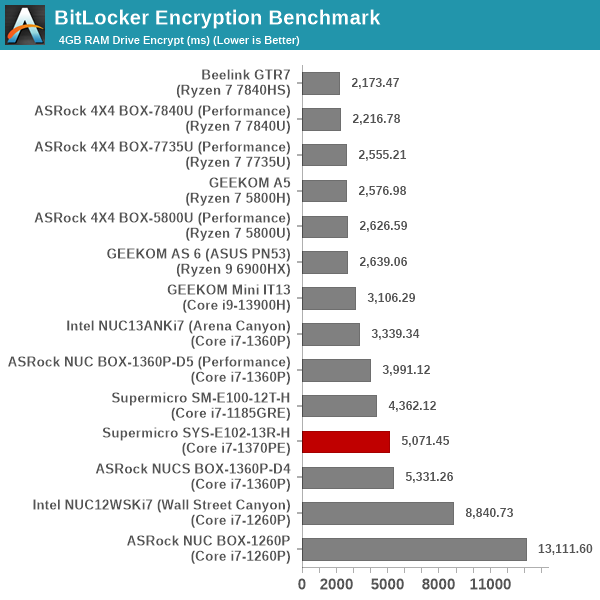
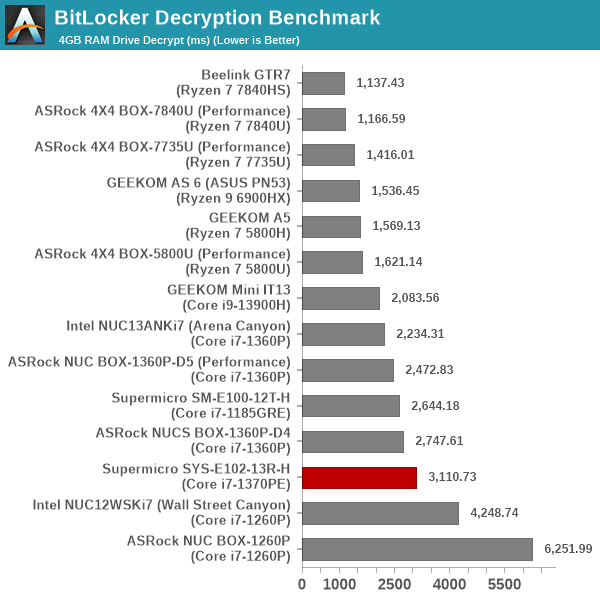
Hardware acceleration is available for the operations in all of the systems. The time taken for processing is directly dependent on the available power budget. AMD's solution consistently outperforms the Intel implementation, likely due to larger number of faster cryptography engines (which are on a per-core basis). With the slightly lower power budget compared to the NUCs, the SYS-E102-13R-H makes its appearance in the lower half of the pack.
GPU Performance: Synthetic Benchmarks
GPUs in embedded SBCs are intended to be used for a variety of workloads such as driving digital signage and kiosk GUIs, as well as limited applications such as arcade gaming. The focus is more on being able to drive a large number of displays, rather than raw gaming performance. The GPU in the Intel Core i7-1370PE is based on the Iris (Xe) iGPU microarchitecture. With 96 EUs, this is the top-end in the Raptor Lake family with a clock speed of 1.4 GHz. As we shall see in the benchmark numbers below, there is not much of an extra power headroom due to the 28W PL1 limitation for the processor package.
The Intel Iris Xe Graphics in the Supermicro SYS-E102-13R-H is an integrated GPU based on a reworked scalable architecture. In the consumer market, it is a couple of generations old, but that is not much of a concern for embedded systems.
GFXBench
The DirectX 12-based GFXBench tests from Kishonti are cross-platform, and available all the way down to smartphones. As such, they are not very taxing for discrete GPUs and modern integrated GPUs. We processed the offscreen versions of the 'Aztec Ruins' benchmark.
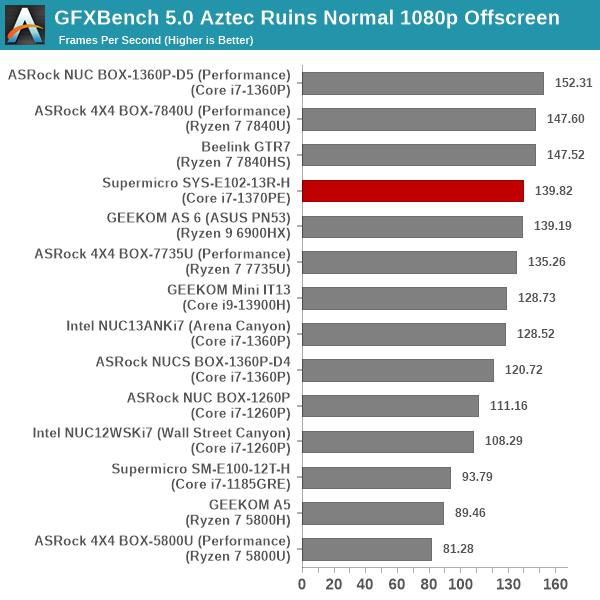
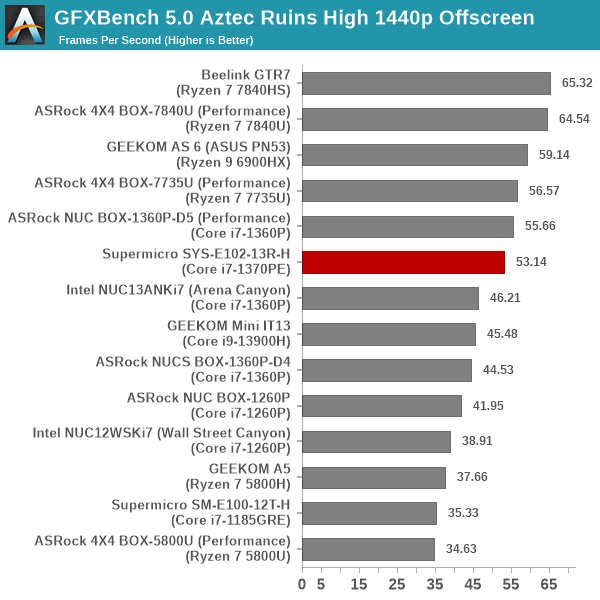
The top-end iGPU in the Core i7-1370PE allows the SYS-E102-13R-H to punch above its weight (read, power budget) and sneak into the upper half of the above graphs. The systems above it have a much higher processor TDP and/or more powerful iGPU microarchitecture.
UL 3DMark
Four different workload sets were processed in 3DMark - Fire Strike, Time Spy, Night Raid, and Wild Life.
3DMark Fire Strike
The Fire Strike benchmark has three workloads. The base version is meant for high-performance gaming PCs. It uses DirectX 11 (feature level 11) to render frames at 1920 x 1080. The Extreme version targets 1440p gaming requirements, while the Ultra version targets 4K gaming system, and renders at 3840 x 2160. The graph below presents the overall score for the Fire Strike Extreme and Fire Strike Ultra benchmark across all the systems that are being compared.
| UL 3DMark - Fire Strike Workloads | |||
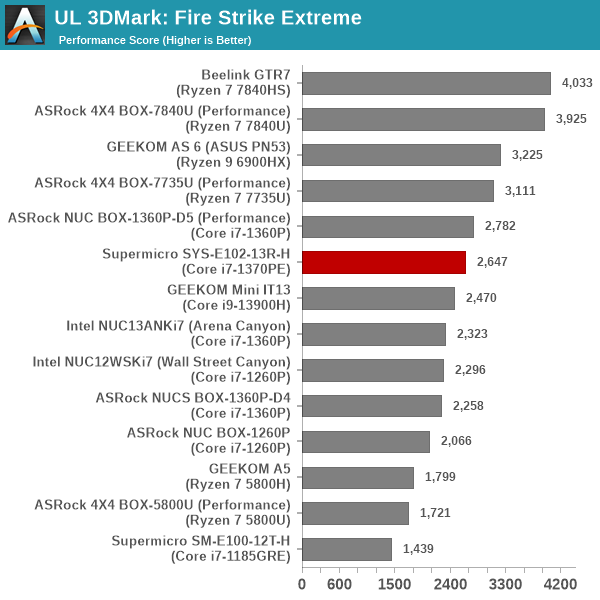
Despite the lower PL1 compared to many other systems, the EU count helps the SYS-E102-13R-H to get into the upper half of the pack at both resolutions.
3DMark Time Spy
The Time Spy workload has two levels with different complexities. Both use DirectX 12 (feature level 11). However, the plain version targets high-performance gaming PCs with a 2560 x 1440 render resolution, while the Extreme version renders at 3840 x 2160 resolution. The graphs below present both numbers for all the systems that are being compared in this review.
| UL 3DMark - Time Spy Workloads | |||
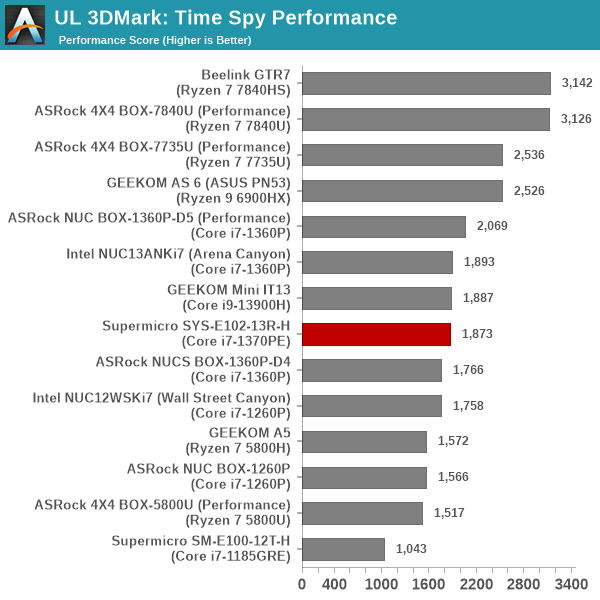
The higher resolution benchmark shows the benefits of the extra EU count in the Core i7-1370PE. At 1440p, the system performs similar to a bunch of other Raptor Lake-P/-H mini-PCs, with their scores being in the realm of run-to-run variations.
3DMark Wild Life
The Wild Life workload was initially introduced as a cross-platform GPU benchmark in 2020. It renders at a 2560 x 1440 resolution using Vulkan 1.1 APIs on Windows. It is a relatively short-running test, reflective of mobile GPU usage. In mid-2021, UL released the Wild Life Extreme workload that was a more demanding version that renders at 3840 x 2160 and runs for a much longer duration reflective of typical desktop gaming usage.
| UL 3DMark - Wild Life Workloads | |||
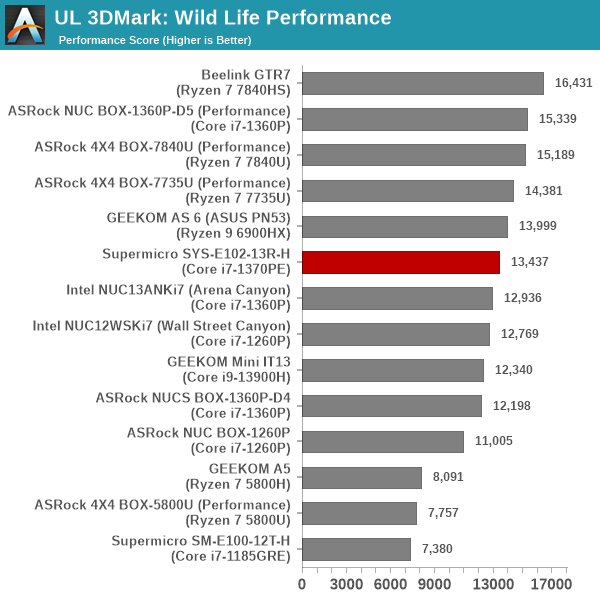
This benchmark appears to benefit systems with higher power budget, rather than the EU count in the iGPU. Despite that, the SYS-E102-13R-H manages to make its mark in the upper half of the compared set.
3DMark Night Raid
The Night Raid workload is a DirectX 12 benchmark test. It is less demanding than Time Spy, and is optimized for integrated graphics. The graph below presents the overall score in this workload for different system configurations.
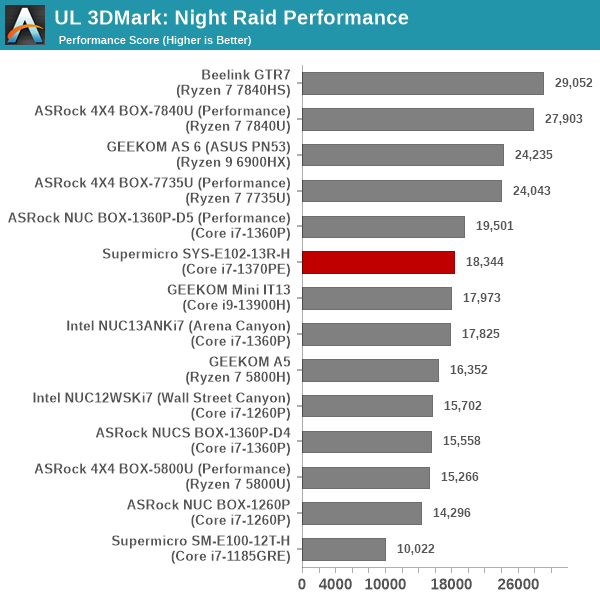
Similar to most of the other benchmark numbers presented above, the EU count helps the SYS-E102-13R-H perform well enough to be in the upper half of the graph despite the limited power budget.
Workstation Performance - SPECworkstation 3.1
SFF systems targeting the embedded market traditionally do not lend themselves to workstation duties. However, a recent trend towards miniaturized workstations has been observed. While the SYS-E102-13R-H is primarily marketed towards embedded use-cases, its capabilities encouraged us to benchmark the system for both content creation workloads as well as professional applications. Towards this, we processed the SPECworkstation 3.10 benchmark suite.
The SPECworkstation 3.1 benchmark measures workstation performance based on a number of professional applications. It includes more than 140 tests based on 30 different workloads that exercise the CPU, graphics, I/O and memory hierarchy. These workloads fall into different categories.
- Media and Entertainment (3D animation, rendering)
- Product Development (CAD/CAM/CAE)
- Life Sciences (medical, molecular)
- Financial Services
- Energy (oil and gas)
- General Operations
- GPU Compute
Individual scores are generated for each test and a composite score for each category is calculated based on a reference machine (HP Z240 tower workstation using an Intel E3-1240 v5 CPU, an AMD Radeon Pro WX3100 GPU, 16GB of DDR4-2133, and a SanDisk 512GB SSD). Official benchmark results generated automatically by the benchmark itself are linked in the table below for the systems being compared.
| SPECworkstation 3.1 Official Results (2K) | |
| Supermicro SYS-E102-13R-H | Run Summary |
| ASRock 4X4 BOX-5800U (Performance) | Run Summary |
| Supermicro SM-E100-12T-H | Run Summary |
| Beelink GTR7 | Run Summary |
| ASRock 4X4 BOX-7840U (Performance) | Run Summary |
| ASRock NUC BOX-1360P-D5 (Performance) | Run Summary |
| ASRock 4X4 BOX-7735U (Performance) | Run Summary |
| Intel NUC13ANKi7 (Arena Canyon) | Run Summary |
| ASRock NUCS BOX-1360P-D4 | Run Summary |
| GEEKOM A5 | Run Summary |
| Intel NUC12WSKi7 (Wall Street Canyon) | Run Summary |
| ASRock NUC BOX-1260P | Run Summary |
| GEEKOM AS 6 (ASUS PN53) | Run Summary |
| GEEKOM Mini IT13 | Run Summary |
Details of the tests in each category, as well as an overall comparison of the systems on a per-category basis are presented below.
Media and Entertainment
The Media and Entertainment category comprises of workloads from five distinct applications:
- The Blender workload measures system performance for content creation using the open-source Blender application. Tests include rendering of scenes of varying complexity using the OpenGL and ray-tracing renderers.
- The Handbrake workload uses the open-source Handbrake application to transcode a 4K H.264 file into a H.265 file at 4K and 2K resolutions using the CPU capabilities alone.
- The LuxRender workload benchmarks the LuxCore physically based renderer using LuxMark.
- The Maya workload uses the SPECviewperf 13 maya-05 viewset to replay traces generated using the Autodesk Maya 2017 application for 3D animation.
- The 3ds Max workload uses the SPECviewperf 13 3dsmax-06 viewset to replay traces generated by Autodesk's 3ds Max 2016 using the default Nitrous DX11 driver. The workload represents system usage for 3D modeling tasks.
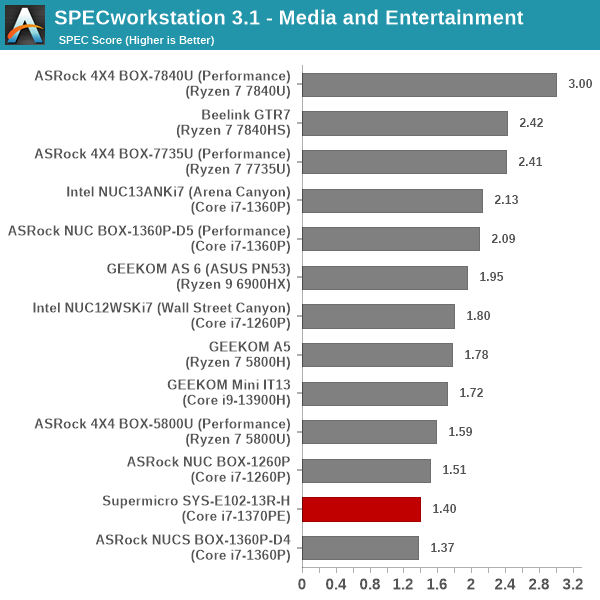
Product Development
The Product Development category comprises of eight distinct workloads:
- The Rodinia (CFD) workload benchmarks a computational fluid dynamics (CFD) algorithm.
- The WPCcfd workload benchmarks another CFD algorithm involving combustion and turbulence modeling.
- The CalculiX workload uses the Calculix finite-element analysis program to model a jet engine turbine's internal temperature.
- The Catia workload uses the catia-05 viewset from SPECviewperf 13 to replay traces generated by Dassault Systemes' CATIA V6 R2012 3D CAD application.
- The Creo workload uses the creo-02 viewset from SPECviewperf 13 to replay traces generated by PTC's Creo, a 3D CAD application.
- The NX workload uses the snx-03 viewset from SPECviewperf 13 to replay traces generated by the Siemens PLM NX 8.0 CAD/CAM/CAE application.
- The Solidworks workload uses the sw-04 viewset from SPECviewperf 13 to replay traces generated by Dassault Systemes' SolidWorks 2013 SP1 CAD/CAE application.
- The Showcase workload uses the showcase-02 viewset from SPECviewperf 13 to replay traces from Autodesk's Showcase 2013 3D visualization and presentation application
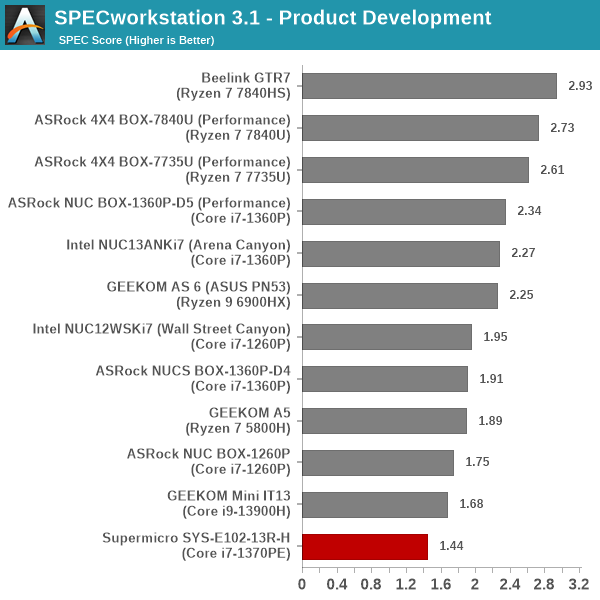
Life Sciences
The Life Sciences category comprises of four distinct test sets:
- The LAMMPS set comprises of five tests simulating different molecular properties using the LAMMPS molecular dynamics simulator.
- The NAMD set comprises of three tests simulating different molecular interactions.
- The Rodinia (Life Sciences) set comprises of four tests - the Heartwall medical imaging algorithm, the Lavamd algorithm for calculation of particle potential and relocation in a 3D space due to mutual forces, the Hotspot algorithm to estimate processor temperature with thermal simulations, and the SRAD anisotropic diffusion algorithm for denoising.
- The Medical workload uses the medical-02 viewset from SPECviewperf 13 to determine system performance for the Tuvok rendering core in the ImageVis3D volume visualization program.

Financial Services
The Financial Services workload set benchmarks the system for three popular algorithms used in the financial services industry - the Monte Carlo probability simulation for risk assessment and forecast modeling, the Black-Scholes pricing model, and the Binomial Options pricing model.
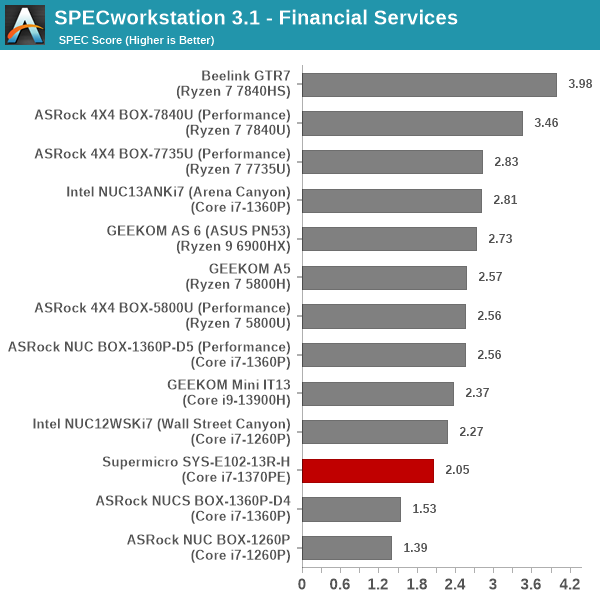
Energy
The Energy category comprises of workloads simulating various algorithms used in the oil and gas industry:
- The FFTW workload computes discrete Fourier transforms of large matrices.
- The Convolution workload computes the convolution of a random 100x100 filter on a 400 megapixel image.
- The SRMP workload processes the Surface-Related Multiples Prediction algorithm used in seismic data processing.
- The Kirchhoff Migration workload processes an algorithm to calculate the back propogation of a seismic wavefield.
- The Poisson workload takes advantage of the OpenMP multi-processing framework to solve the Poisson's equation.
- The Energy workload uses the energy-02 viewset from SPECviewperf 13 to determine system performance for the open-source OPendTec seismic visualization application.
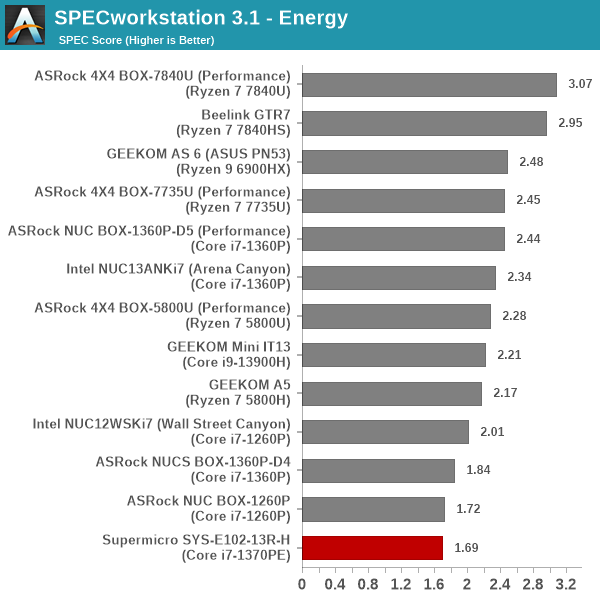
General Operations
In the General Options category, the focus is on workloads from widely used applications in the workstation market:
- The 7zip workload represents compression and decompression operations using the open-source 7zip file archiver program.
- The Python workload benchmarks math operations using the numpy and scipy libraries along with other Python features.
- The Octave workload performs math operations using the Octave programming language used in scientific computing.
- The Storage workload evaluates the performance of the underlying storage device using transaction traces from multiple workstation applications.
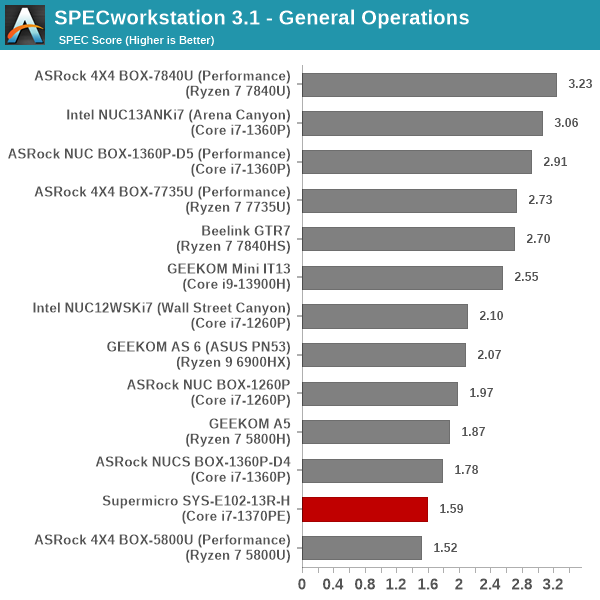
GPU Compute
In the GPU Compute category, the focus is on workloads taking advantage of the GPU compute capabilities using either OpenCL or CUDA, as applicable:
- The LuxRender benchmark is the same as the one seen in the media and entertainment category.
- The Caffe benchmark measures the performance of the Caffe deep-learning framework.
- The Folding@Home benchmark measures the performance of the system for distributed computing workloads focused on tasks such as protein folding and drug design.
We only process the OpenCL variants of the benchmark, as the CUDA version doesn't process correctly with default driver installs.
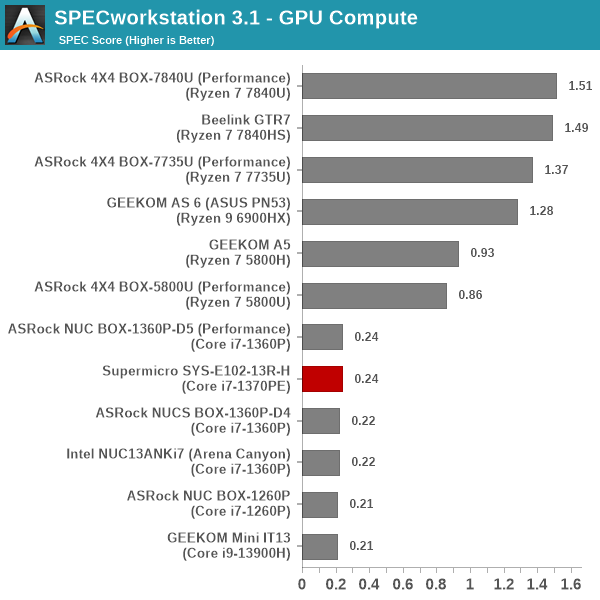
Most of the workloads in the SPECworkstation 3.1 suite benefit immensely from multiple fast cores with a large power budget. Unfortunately, the 28W PL1 of the Core i7-1370PE in the SYS-E102-13R-H is detrimental to these long-running workloads, and the system ends up in the lower half of the pack in all the components.
Digital Signage and Multimedia Credentials
The 2022 Q4 update to our system reviews brings an updated multimedia playback evaluation suite. After doing away with the evaluation of display refresh rate stability and Netflix streaming evaluation, the local media playback configurations have also seen a revamp. This section details each of the workloads processed on the Supermicro SYS-E102-13R-H as part of this suite.
YouTube Streaming Efficiency
YouTube continues to remain one of the top OTT platforms, primarily due to its free ad-supported tier. Our HTPC test suite update retains YouTube streaming efficiency evaluation as a metric of OTT support in different systems. Mystery Box's Peru 8K HDR 60FPS video is the chosen test sample. On systems running Windows, it is recommended that HDR streaming videos be viewed using the Microsoft Edge browser after putting the desktop in HDR mode.
The GPU in Supermicro SYS-E102-13R-H supports hardware decoding of AV1, and we see the stream encoded with that codec being played back. The streaming is perfect, thanks to the powerful GPU and hardware decoding support - the couple of dropped frames observed in the statistics below are due to mouse clicks involved in bringing up the overlay.
The streaming efficiency-related aspects such as GPU usage and at-wall power consumption are also graphed below.
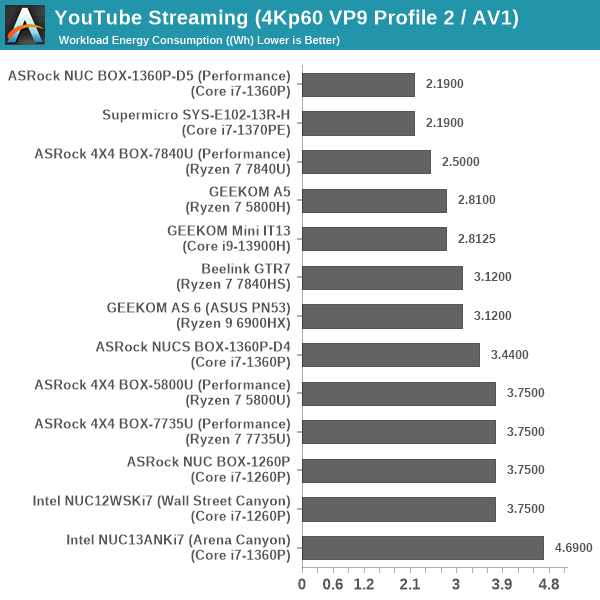
AV1 streaming appears to consume lesser energy compared to VP9 Profile 2 streaming in the older PCs. The SYS-E102-13R-H is on top in terms of playback efficiency in this workload.
Hardware-Accelerated Encoding and Decoding
The transcoding benchmarks in the systems performance section presented results from evaluating the QuickSync encoder within Handbrake's framework. The capabilities of the decoder engine are brought out by DXVAChecker.
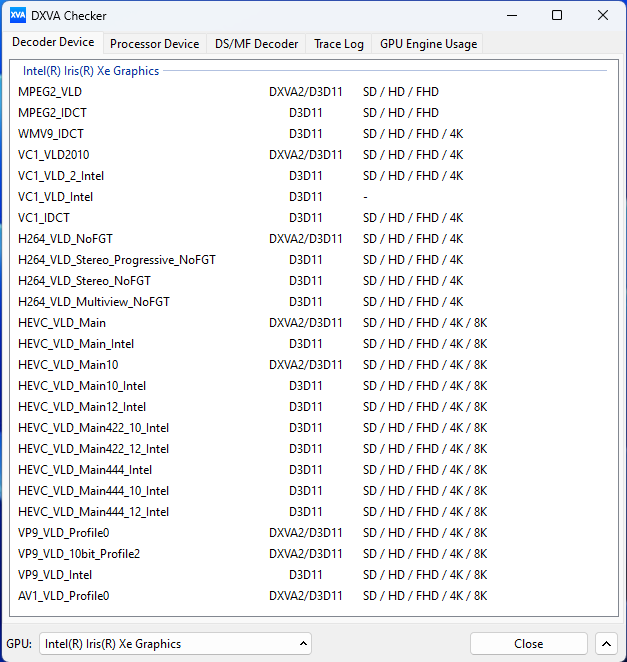
Video Decoding Hardware Acceleration in Supermicro SYS-E102-13R-H
The iGPU in the Core i7-1370PE supports hardware decode for a variety of codecs including AVC, JPEG, HEVC (8b and 10b, 4:2:0 and 4:4:4), and VP9 (8b and 10b, 4:2:0 and 4:4:4). AV1 decode support is also present. This is currently the most comprehensive codec support seen in the PC space.
Local Media Playback
Evaluation of local media playback and video processing is done by playing back files encompassing a range of relevant codecs, containers, resolutions, and frame rates. A note of the efficiency is also made by tracking GPU usage and power consumption of the system at the wall. Users have their own preference for the playback software / decoder / renderer, and our aim is to have numbers representative of commonly encountered scenarios. Our Q4 2022 test suite update replaces MPC-HC (in LAV filters / madVR modes) with mpv. In addition to being cross-platform and open-source, the player allows easy control via the command-line to enable different shader-based post-processing algorithms. From a benchmarking perspective, the more attractive aspect is the real-time reporting of dropped frames in an easily parseable manner. The players / configurations considered in this subsection include:
- VLC 3.0.20
- Kodi 21.0
- mpv 0.38.2 (hwdec auto, vo=gpu-next)
- mpv 0.38.2 (hwdec auto, vo=gpu-next, profile=gpu-hq)
Fourteen test streams (each of 90s duration) were played back from the local disk with an interval of 30 seconds in-between. Various metrics including GPU usage, at-wall power consumption, and total energy consumption were recorded during the course of this playback.
All our playback tests were done with the desktop HDR setting turned on. It is possible for certain system configurations to automatically turn on/off the HDR capabilities prior to the playback of a HDR video, but, we didn't take advantage of that in our testing.
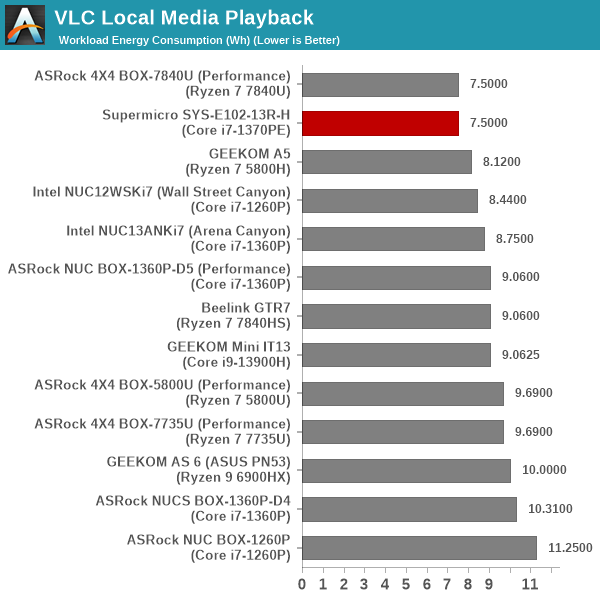
Playback was perfect for all codecs except AV1 (the 8Kp60 decoding was hardware-accelerated, but the presentation lost half the frames), and the power consumption numbers are excellent. The energy consumption numbers land the SYS-E102-13R-H right on top, with the low PL1 configuration being of help here.

The scenario seen with VLC was also observed with Kodi. Absolute energy numbers are a bit higher (as the GPU is kept 'busy' even during the idling period from one clip's playback to the next), but the SYS-E102-13R-H continues to be the most energy-efficient of the lot.
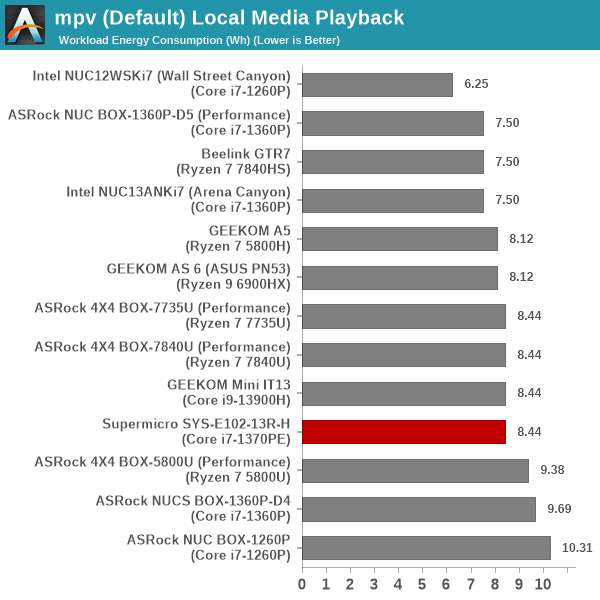

mpv is able to utilize hardware acceleration for all codecs. The 8Kp60 AV1 clip has some presentation issues (with half of the frames getting dropped), but the decoding is done without issues. In terms of energy efficiency, the numbers for the GPU-HQ case are higher, as expected. The activation of the GPU shaders is reflected in the increased D3D Usage, which is also graphed above.
Power Consumption and Thermal Characteristics
The power consumption at the wall was measured with a 4K display being driven through the HDMI port of the system. In the graph below, we compare the idle and load power of the Supermicro SYS-E102-13R-H with other systems evaluated before. For load power consumption, we ran the AIDA64 System Stability Test with various stress components, as well as our custom stress test with Prime95 / Furmark, and noted the peak as well as idling power consumption at the wall.
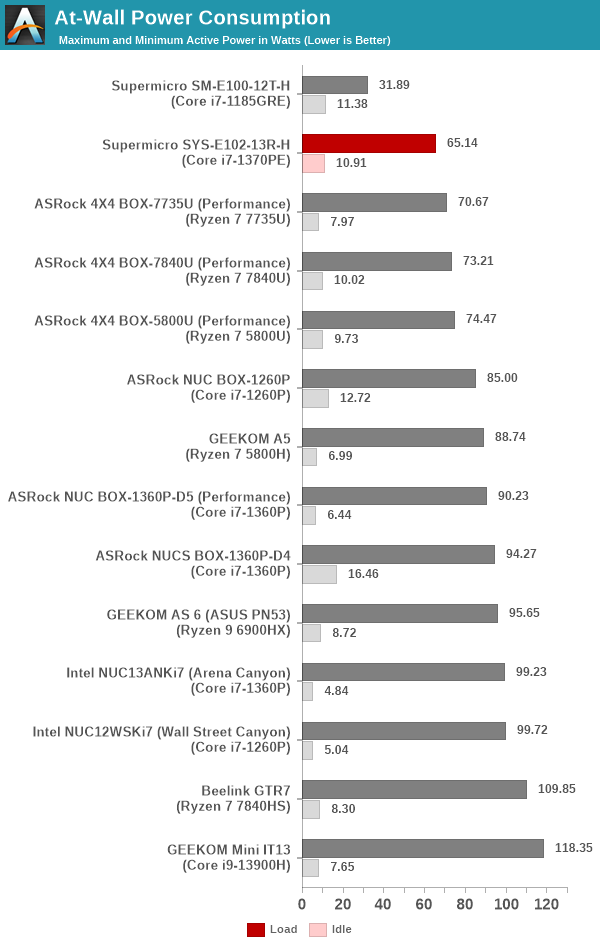
The numbers are consistent with the TDP and suggested PL1 / PL2 values for the processors in the systems, and do not come as any surprise. The SYS-E102-13R-H has the numbers configured as 28 W and 44 W, and the peak 65W number is as expected. Idling power could be much better, as we have seen the Intel NUCs with optimized BIOS configurations idle at around 5W (compared to the 10W+ seen for the SYS-E102-13R-H).
Stress Testing
Our thermal stress routine is a combination of Prime95, Furmark, and Finalwire's AIDA64 System Stability Test. The following 9-step sequence is followed, starting with the system at idle:
- Start with the Prime95 stress test configured for maximum power consumption
- After 30 minutes, add Furmark GPU stress workload
- After 30 minutes, terminate the Prime95 workload
- After 30 minutes, terminate the Furmark workload and let the system idle
- After 10 minutes of idling, start the AIDA64 System Stress Test (SST) with CPU, caches, and RAM activated
- After 30 minutes, terminate the previous AIDA64 SST and start a new one with the GPU, CPU, caches, and RAM activated
- After 30 minutes, terminate the previous AIDA64 SST and start a new one with only the GPU activated
- After 30 minutes, terminate the previous AIDA64 SST and start a new one with the CPU, GPU, caches, RAM, and SSD activated
- After 30 minutes, terminate the AIDA64 SST and let the system idle for 10 minutes
Traditionally, this test used to record the clock frequencies - however, with the increasing number of cores in modern processors and fine-grained clock control, frequency information makes the graphs cluttered and doesn't contribute much to understanding the thermal performance of the system. The focus is now on the power consumption and temperature profiles to determine if throttling is in play.
The thermal solution in the SYS-E102-13R-H is excellent - the package power doesn't dip below the PL1 value of 28 W throughout the stress duration. The iGPU alone seems to have a peak power budget of 19.2 W. The PL2 value of 44 W appears to be a bit conservative for the cooling solution, as the maximum temperature stays south of 90C even after the PL2 duration is finished. Given the target market's requirement for 24x7 deployment with long product life, the conservative approach is acceptable.
Miscellaneous Aspects and Concluding Remarks
Networking and storage are aspects that may be of vital importance in specific PC use-cases. The Supermicro SYS-E102-13R-H comes with support for a M.2 2230 WLAN/BT card, as well as a nano SIM slot. Interested users can add their own solution for wireless connectivity. On the wired front, we have two NBASE-T ports (up to 2.5 Gbps each). From a management perspective, the CPU is vPro-enabled - AMT and native dual LAN support allows out-of-band management with a dedicated LAN port, if necessary.
On the storage side, some applications require wide-temperature range and/or high endurance SSDs. Our review sample of the Supermicro SYS-E102-13R-H came with a PCIe 3.0 x4 InnoDisk NVMe SSD. It is no match for the performance provided by the Gen 4 NVMe SSDs in other systems. From a benchmarking perspective, we provide results from the WPCstorage test of SPECworkstation 3.1. This benchmark replays access traces from various programs used in different verticals and compares the score against the one obtained with a 2017 SanDisk 512GB SATA SSD in the SPECworkstation 3.1 reference system.
| SPECworkstation 3.1.0 - WPCstorage SPEC Ratio Scores | |||
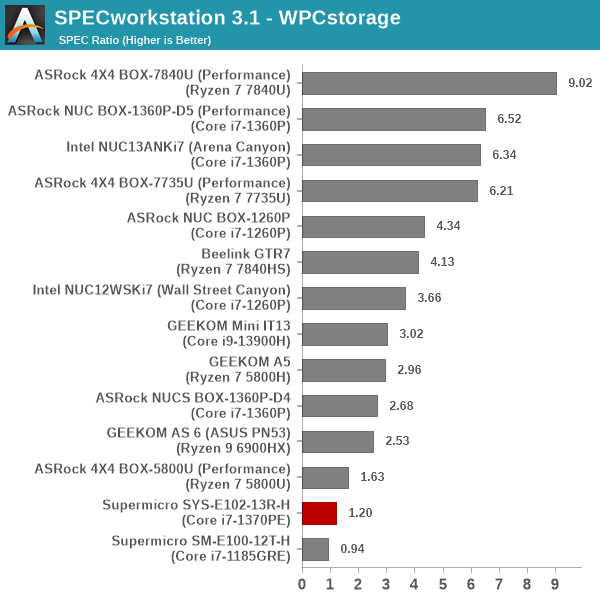
The graphs above present results for different verticals, as grouped by SPECworkstation 3.1. The storage workload consists of 60 subtests. Access traces from CFD solvers and programs such as Catia, Creo, and Soidworks come under 'Product Development'. Storage access traces from the NAMD and LAMMPS molecular dynamics simulator are under the 'Life Sciences' category. 'General Operations' includes access traces from 7-Zip and Mozilla programs. The 'Energy' category replays traces from the energy-02 SPECviewperf workload. The 'Media and Entertainment' vertical includes Handbrake, Maya, and 3dsmax. Given that the comparison is between a wide range of SSDs in the systems - including both Gen 3 and Gen 4 NVMe, as well as SSDs using DRAM for the flash translation layer, and others using either host memory buffer or operating in DRAM-less mode, the relative numbers for most workloads are not surprising. The InnoDisk Gen 3 drive in DRAM-less mode is rated for wide-temperature operation, but the benchmark numbers cut a sorry figure and leave the SYS-E102-13R-H towards the bottom of the pack. From an embedded PC perspective, the key aspect is the industrial rating / wide operating temperature range for the SSD itself. This ensures ability of the storage device to withstand operation in demanding environmental conditions.
Closing Thoughts
The Supermicro SYS-E102-13R-H provided us with the opportunity to evaluate a 3.5-inch SBC targeting embedded applications. The motherboard itself is loaded with plenty of features, but the chassis used to create the SYS-E102-13R-H has cut-outs only for the LAN ports and the built-in USB Type-A and Type-C ports. The Core i7-1370PE is an excellent processor with particularly impressive graphics performance for its configured PL1 value of 28 W. The system also supports four independent displays with its two HDMI ports and two Type-C ports. This opens up a wide variety of use-cases in the digital signage market. The single-threaded performance for the power budget is currently among the best in the embedded space.
The system comes with vPro / AMT support, enabling remote monitoring and administration. The power limits are conservatively configured at 28 W / 44 W, which is reasonable for an actively-cooled compact 3.5-inch SBC targeting the embedded market. It contributes to long-term product reliability.
In terms of scope for improvement, a different chassis with support for additional USB / COM ports (similar to the fanless Tiger Lake-based SM-E100-12T-H) could have opened up many additional use-cases. USB4 / 40 Gbps support in the Type-C ports (sourcing both from the native Thunderbolt ports in the processor) could have lent to additional differentiation. Obviously, USB4 (or, for that matter, even Type-C itself) has not yet taken off in the embedded market. Therefore, Supermicro's decision to limit the Type-C ports to 10 Gbps may be acceptable if there are cost-savings in the picture.
In terms of pricing, the barebones version is priced around $1000. This is par for the course for compact high-performance embedded PCs targeting the B2B market. Supermicro has a wide variety of such systems available for the IoT market segment. The SYS-E102-13R-H ticks all the right boxes. It is a solid offering for specific use-cases in applications such as IoT gateways, digital signage and kiosk duties, and edge computing.

